Games Mentioned:
- Inversus
- Samurai Gunn
- TowerFall
- Super Monkey Ball
- Pac-Man
- BaraBariBall
Games Mentioned:
 POV: DESIGN. DIFFICULTY 4. LEVEL 5 – 1
POV: DESIGN. DIFFICULTY 4. LEVEL 5 – 1
With video games it’s common for levels to increase in difficulty as the game progresses. I knew this was the case for games as old as Pac-Man. But when I read through Jamey Pittman’s Pac-Man Dossier, I was surprised how many variables were tweaked to give each level its unique challenge.
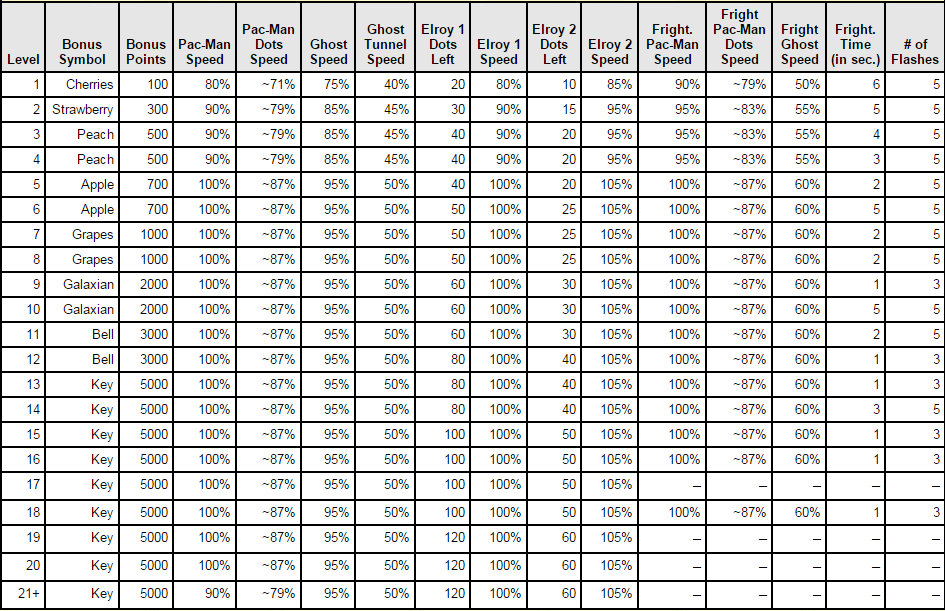
Out of the 21 levels, only a few pairs of levels present an identical gameplay challenge. Otherwise, one of the game’s 13 gameplay variables is tweaked.
Tweaking these variables across the 21 levels in Pac-Man gives players more comprehensive exposure to the design space. Players can better learn Pac-Man’s gameplay by progressing through the game and refining their strategies as the challenges get harder.
When Pac-Man eats an Energizer Power-Pellet his speed changes. In the early levels his speed increases to help players chase vulnerable Ghosts. On the other hand, during this “fright” time Pac-Man’s speed is lowered while he eats Dots. Between levels 4 and 5, the difference of Fright Pac-Man’s dot-eating speed is 4%, a change so subtle that players may not perceive it consciously, but I’m confident that players can feel the difference.
All of the variables listed above control gameplay elements that have clear feedback. Pac-Man and Ghost speed can be discerned by simply observing their sprites for a few seconds of motion. The number of times frightened Ghosts flash before becoming deadly is either 3 or 5; It would be more difficult to determine exactly when Ghosts turn deadly if the number of flashes ranged from 1-5. 1-2 flashes doesn’t give enough warning. 6 flashes is too long. Keeping it 3 and 5 gives players who anticipate a 3 flash change to react accordingly by the 5th flash.
Many variables are tuned to be easier for players to keep track of mentally. Ghosts flash an odd number of times before becoming deadly, which helps musically-inclined players who are used to musical phrases ending on an even beat. Fright times are whole numbers measured in seconds, which makes counting easier. Blinky, the red Ghost, speeds up two times in a level based on the number of Dots left in the maze. The speed values for Blinky are all divisible by 10. Pac-Man’s normal movement speed is also divisible by 10. Pac-Man’s speed matches Blinky’s, a design choice that allows Blinky to chase Pac-Man effectively and makes the tiny speed boost granted when Pac-man rounds corners more obvious. However, when there are very few Dots left in the maze and Blinky moves at his fastest, his speed is consistently 5% faster than Pac-Man’s (except on the final level of difficulty where it’s 15% faster). This consistency among all the other changing variables in Pac-Man’s difficulty design goes a long way in making the interactions easier to learn yet variable. No matter how Pac-Man’s speed changes between levels, players can rely on the ratio of speed between Pac-Man and the most aggressive Ghost, Blinky, to be the same for 20 out of 21 levels.
The most interesting piece of feedback design is the classic “waca waca” sound effect that plays when Pac-man consumes a Dot: Pac-Man’s slight speed change when rounding corners while eating Dots can be can be seen as well as heard! Listen here.
 POV: JOURNALIST. DIFFICULTY 3. LEVEL 1 – 1
POV: JOURNALIST. DIFFICULTY 3. LEVEL 1 – 1
Game difficulty is hard to discuss especially for games like Pokemon. In this video Speedster presents a top 10 list of the hardest story battles in the Pokemon RPG series. Speedster’s video interests me not because of what he had to say about the difficulty design of Pokemon, but because he struggles to frame the discussion of difficulty. He opens with this:
“why are some battles just really hard?”
“I know that most battles in RPGs in general are really easy if you just grind levels and quite hard if you don’t grind levels.”
Speedster attempts to pin down the variance in the player’s Pokemon and items by stipulating that the notional player uses properly-leveled Pokemon for each battle. I assume “properly leveled” means that the player’s Pokemon levels closely matches the opposing Pokemon’s levels.
Speedster struggles to describe the conditions that make many of the battles in his top 10 difficult. Sometimes the opposing Pokemon have stronger moves. Sometimes the challenge is due to a Pokemon type disadvantage because of the availability of catchable Pokemon. Sometimes the lack of Speedster’s offensive strength increased the effect of random moves like METRONOME, SMOKE SCREEN, or DOUBLE TEAM from the opposing team. Basically, when he couldn’t KO the opposing Pokemon fast enough, his opponent had time to set up a some nasty situations.
“I only won with luck”
Throughout these descriptions Speedster doesn’t articulate how challenging the battles are in a consistent, objective, or measurable way. Instead he gauges difficulty generally by describing opposing Pokemon strength, the number of times he retried the battle, how frustrated he was, or if he had to leave the gym to grind a few more levels.
“I never had to.. reset and try again or go off and grind without losing. Easily the hardest champion for me.”
“I have never gone through this gym without at least a few of my Pokemon fainting”
The Pokemon battle system design space is massive and allows for an incredible diversity of strategies (read more here). For games like Pokemon, I’ve found that difficulty spikes occur not because the challenges gets much harder in a linear way; it’s not because the designers all of a sudden make the difficulty curve steeper by simply adjust one variable like enemy level. Rather it’s because the challenges start to require players to explore specific parts of the design space and use specific counter strategies. These challenges push the player to take advantage of elements of the complexity and depth of the game that they had been previously ignoring. For these battles, general strategies used previously will not be effective.
“[The Norman Gym battle in Pokemon Ruby/Sapphire] is a huge spike in difficulty curve”
Speedster didn’t describe using any boosting items, like X Speed or X Defense. Maybe he’s used to competitive battling where items are banned, so he chooses not to use such items in the single-player story battles. But trading for Pokemon and using items in battle is a legitimate part of the single-player game. This is a clear case of a player making challenges harder for himself by not exploring all the options available to him. I don’t blame Speedster. I do the same thing when I play Pokemon. Not only do such choices make the difficulty design of the game harder to grasp, but it makes talking about the difficulty of these challenges even harder.
 POV: PLAYER. DIFFICULTY 4. LEVEL 1 – 1
POV: PLAYER. DIFFICULTY 4. LEVEL 1 – 1
Final Fantasy Tactics 1.3 is a fan mod that attempts to balance the generic Jobs and tune the game to be a challenge even to knowledgeable and skilled players. It’s not for the faint of heart. FFT1.3 seems to address some of my complaints about the original FFT and stands to really test my knowledge of the game.

One of the first big notes I took after the first three missions is that the characters I choose for each mission really matter, both in terms of mission success in the short-term and getting key characters enough XP and JP in the medium-term. From the first mission I had to pick who I wanted to make great, then stick with them. And in battles, I needed to be very conscientious with regard to making sure my characters were getting the JP that they need to keep up the progression pace. Just fighting to survive and win wasn’t good enough–I had to find something useful for each character to do each turn, even if it was just putting a relatively useless buff on an ally, so that my characters could catch up with Algus and Delita, two ally story characters controlled by the AI in the first few missions.
My first attempt through the first three missions (Gariland, Mandalia Plains, Sweegy Woods) I did not do a good-enough job of leveling up my characters, so I was stuck without any Wizards for the fourth mission, Dorter Slums. I needed my starting party to consist of some combination of Wizards, Priests, Marksmen, and Knights–not a bunch of red-cheeked Squires and Chemists. Delita and Algus were both level 4 or 5 by the time I hit Dorter, which meant the enemies were going to be at least level 5 and have real Jobs. I couldn’t bring rookies to this battle and hope to survive. The Marksmen and Wizards you face here have enough ranged firepower to overwhelm the healing efforts of a couple of Chemists–much unlike Mandalia Plains and Sweegy Woods which I had no trouble winning by playing defensively with a 2 Chemist 2 Squire team, focusing damage while healing whenever possible.
When I noticed that I was unprepared for Dorter, I tried to train up characters by fighting random encounters in Mandalia Plains. Wow, that was a mistake! The random encounters in 1.3 are quite tough–no place to bring a rookie to get him a few easy levels even this early in the game. The fact that Delita and Algus were level 5 meant that even the highest-level characters I could deploy were outleveled by the opposition by two whole levels. Though no damage or hit-rate calculations use character level directly, the enemies the game generates for random encounters use the player’s party’s highest level to guide how many abilities the enemies have have. As such, what should be challenging but fair battles for a level 5 party were murder on my party of level 3 characters. After trying a few random encounters and meeting brutal failure, I reassessed my entire progression strategy. I found out the hard way that the first few ability unlocks and job unlocks are so important that when the enemy had them and I didn’t, it was game over.
On my second try through the first three missions I did much better. I ensured I’d accumulate enough JP by setting up a trap in Mandalia Plains to pin an enemy Squire in place so that I could have my characters heal Delita and Algus repeatedly and farm some XP and JP. I was careful to avoid leveling past Delita and Algus, though, because in 1.3 enemy gear and levels scale with the highest level character in your party for all battles. If you outlevel the gear that you can buy in shops, you’re stuck with junk while the enemy has level-appropriate equipment. This means more damage and HP for enemies that are already at an advantage in numbers and positioning.

With a more advanced team I managed to complete Dorter, the first major hurdle in 1.3, on my first try. It felt great!
I’ve had lots of fun in these first few hours of play! This fan mod has forced me to engage with the game on a much deeper level than I ever had before, and for that I’m very thankful. I’ll be tackling the next couple of missions over the coming week. Expect another report soon.
 POV: DESIGNER. DIFFICULTY 3. LEVEL 3 – 1
POV: DESIGNER. DIFFICULTY 3. LEVEL 3 – 1
It’s time for the judge to be judged. We’ve nearly come to the end of our Vlambeer Scale article series. So far we’ve used the Vlambeer Scale of Quality to measure the Vlambeerian game feel of Ridiculous Fishing, Ninja Fishing, and an upcoming indie game called Downwell. Now the question is how do Vlambeer’s games measure up?
The following is a list of Vlambeer’s games in chronological order and some of the points from the Vlambeer Scale of Quality that each game does not have.
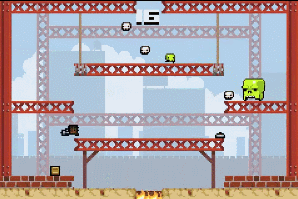 Muzzle Flash, Impact Effects, Enemy Knockback, No level of permanence, Lerp (no camera manipulation at all), Sleep (only for katana), Strafing
Muzzle Flash, Impact Effects, Enemy Knockback, No level of permanence, Lerp (no camera manipulation at all), Sleep (only for katana), Strafing

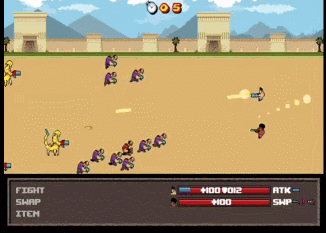 Enemy Knockback, Level 2 and 3 permanence, Player knockback, Sleep, Gun delay, Camera kick, Meaning
Enemy Knockback, Level 2 and 3 permanence, Player knockback, Sleep, Gun delay, Camera kick, Meaning

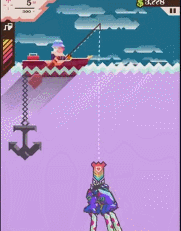 Hit Animation, Player Knockback (guy is in a boat), Strafing
Hit Animation, Player Knockback (guy is in a boat), Strafing

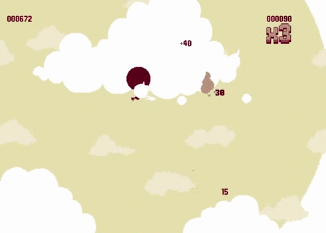 Less Accuracy: No random spread with “Spread” weapon, Hit Animation, Enemy Knockback, Player Knockback (you are a plane), More Bass
Less Accuracy: No random spread with “Spread” weapon, Hit Animation, Enemy Knockback, Player Knockback (you are a plane), More Bass

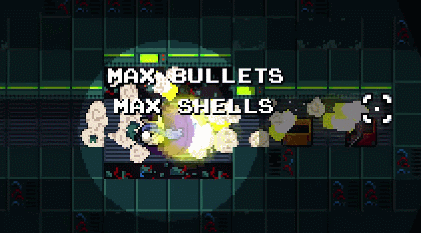 Random explosions, gun kickback, Player knockback
Random explosions, gun kickback, Player knockback

Marcus says:
Richard says: back in 2010, I wrote a blog post on Super Crate Box on Critical-Gaming. Here are three points I made. Key words are bolded and Vlambeer terms are added in brackets where appropriate:
Looks like the game feel of Super Crate Box is an important part of the experience and an important talking point. After all, I wrote this 5 years before we started the Vlambeer Scale of Quality here at Design Oriented.
 POV: DESIGNER. DIFFICULTY 3. LEVEL 1 – 1
POV: DESIGNER. DIFFICULTY 3. LEVEL 1 – 1
[Perfect Dark Retrospective] is a post by Mark R. Johnson that addresses critical claims about Perfect Dark. He takes a detailed look at several levels in Perfect Dark and concludes by considering the validity of the critics’ claims. Topics include level design, difficulty design, tutorial design, and modern FPS trends.
Richard says: Let’s go Perfect Dark! Still my favorite single-player FPS campaign. Mark R Johnson does a great job setting up the conversation with quotes from reviewers. Mark picks a few of the most interesting levels in the game due to their differences between difficulty and their use, and re-use, of space. His descriptions are accurate, though I imagine the screenshots are hard to follow if you’re not familiar with Perfect Dark.
Mark analyzes Perfect Dark levels for “completeness” to counter the claims made by many reviewers that the game is filled with dead ends. Mark illustrates how interconnected the areas, missions, and optional sub-missions are across the level and across the three different difficulty modes. Perfect Dark, after all, is a rare FPS that adds objectives, alters objectives, and changes the path of a level to create distinct experiences.
Mark addresses Perfect Dark’s unique “complete” level design to counter part of the critic’s claims, and then agrees with them regarding the game’s feedback issues. The environment design of the game makes it fairly easy for players to get lost at times. Coupled with the non-linear level design (players can take many paths and accomplish mission objectives in different orders) getting lost is more likely and more frustrating than in linear games. Mark explains the problems of Perfect Dark’s level design, and ends by arguing that “contemporary FPS games” have gone too far in the other design direction to remedy this problem by designing levels where the path to take is more obvious and the level design is more linear.
Perfect Dark is a complex game to analyze in terms of how it teaches, guides, and challenges players. Mark has only scratched the surface by highlighting the coherent details with Perfect Dark’s level design.
Mike Says: It’s interesting how players, even those who have been playing games for more than a decade, have come to rely on the linearity of modern shooter level design on a subconscious level; how it’s far from certain–in fact it is becoming less common by the day–that a player will pick up on the more advanced or subtle level design concepts that could clarify the seemingly arbitrary locked door here or samey-looking room there. A game like Perfect Dark ends up suffering not because of some inherent objective weakness in its level design, but because the kind of headspace required to enjoy it as it was enjoyed shortly after release just isn’t practiced and available to players like it used to be, either because those players never had to practice it, or because they’ve long since been retrained by the zeitgeist of shooter level design.
 POV: DESIGNER. DIFFICULTY 3. LEVEL 4 – 1
POV: DESIGNER. DIFFICULTY 3. LEVEL 4 – 1
My recent deep dive into Pac-Man’s design and high-level gameplay got me thinking about randomness and deterministic design elements. I’m quite a fan of randomness in game design, though it has its pros and cons. Pros include variation and unpredictability that force player improvisation. Cons include a lowered skill ceiling and a lack of player control.
The original Pac-Man arcade version strikes a delicate balance between randomization and determinism with its Ghost AI design. In Pac-Man the Ghosts change back and forth between chase and scatter AI modes. In both modes, Ghost movement is determined by a number of factors including the other Ghosts’ positions and Pac-Man’s position. Given the same positions, the Ghosts will act the same way every time.
When Pac-Man eats a power-pellet, the Ghosts run from Pac-Man in a frightened state. At every turn, they make a random decision which way to go. During this time, Pac-Man usually has zero threats on the field, so the random Ghost movement mostly affects the player’s ability to maximize score as opposed to limiting their ability to make informed decisions at times when their life is on the line. It’s a touch of randomness that that proves the skill of the designer and the potency of randomness as a design element.
On the highest difficulty levels, Ghosts don’t turn blue and don’t become vulnerable even when Pac-Man eats a Power-Pellet! Here, the exact positions of Ghosts is the result of a complex web of deterministic rules. If you play precisely the same way every time, the Ghosts will move predictably through the maze. Of course, it takes considerable planning and skill to work out a whole pathing “patterns” for these levels, but some elite players have done it and can pull them off reliably.
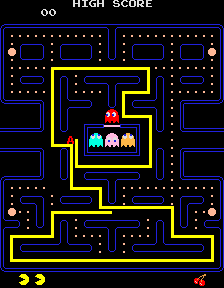 images from mameworld.info
images from mameworld.info
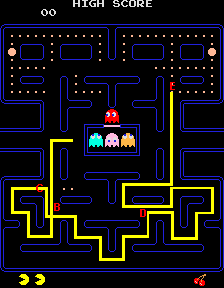
If the perfectly planned pathing pattern is mistimed by even a frame or two, if Pac-Man’s movements are not in exactly the right place at the right time, the Ghost AI will react differently, starting a chain reaction of unplanned and less predictable Ghost movement. When that happens, even the best players have to improvise.
Low- and high-level players both experience the pros of randomness playing the Pac-Man arcade game. The random Ghost frighten movement creates unpredictable challenges without threatening the player in a way that creates unfair deaths. Both knowledge and adaptation (improvisation) are required to succeed. But on the final level of difficulty, expert players engage Pac-Man in a new way, using their skill to maximize score and minimize the unknown. To play at this level of skill, players need impeccable timing and incredible precision. With a microscopic misstep, even the most pre-planned gameplay turns back into the Pac-Man experience that everyone is familiar with.
In response to my article On “Perfect Imbalance”, Travis Clark wrote in with his insightful perspective on balance and memorization in Chess.
 POV: PLAYER. DIFFICULTY 4. LEVEL 1 – 2
POV: PLAYER. DIFFICULTY 4. LEVEL 1 – 2
As for the state of balance in Chess, Travis makes a great point about the subtle nature of the imbalances present in what appears to be a symmetrical system:
“It is almost symmetrical, and visually tricks people into to thinking so with the optical-illusion of black and white squares and the pieces in front of you line up with pieces in-front of your opponent. Fold the board in half along its supposed line of symmetry and you will find every black square folds on top of a white square. The board itself isn’t meant to be symmetrical. Its a very small difference but bishops are assigned to move along a specific color square so the board itself creates some very slight but uneven gameplay. Now take a close look at the pieces. Things look a little different if you are playing black versus playing white. If you are playing as white your king is on the fourth square from the right. If you are playing black, you must look from black’s perspective, your king is on the fifth square from the right. The situation for the queens are similar. I believe it is this way because it is aesthetically pleasing. However, every opening strategy is hinged on this very slightly imbalanced set-up.” ~Travis
In the original article, I had considered making a comment on the fact that Chess is not a symmetrical game, primarily because of White’s first-turn advantage, but Travis brings up a good further point about how the aesthetically-pleasing apparently-symmetrical setup is hiding some one-square positioning differences that rest at the core of the strategy-space of the game. He later also mentioned the importance of first-turn advantage as well:
“The most drastic way chess is imbalanced is the fact that white always goes first. You may wonder how much of a difference white’s privilege actually makes. …Because of the small differences in starting positions and the advantage white has in time there is a Chess theory which states that if two perfect computers were to play each-other, with all the Chess databases known to man for reference material the best outcome black could hope for would be a draw in every game.” ~Travis
Travis pointed out a memorization-free style of learning chess that worked well for him:

“Josh Waitzkin is one of my chess heroes. He wrote an excellent book called The Art of Learning that I highly recommend, and in partnership with Chessmaster(Ubisoft) created a fantastic chess course. The reason why I was drawn in to chess so deeply and find it fascinating are his annotated games. His style of play and teaching didn’t revolve around the learning of specific patterns or memorizing databases. In place of the rote portion he would explain the theory of why certain opening patterns developed and what the Grandmaster’s that used them were trying to accomplish what they gave up and got in return and how it suited their style of play. I never once had been one to memorize openings. Using his training I could look at a completely unfamiliar opening, that my opponent may have memorized, and look at its goal and strengths and weaknesses and choose a move based on that.” ~Travis
And he went on to talk about the mind-games that can be involved in Chess:
“But the heart of chess is this competitive spirit. Connecting with someone through competition is the key. Memorization is a piece of the puzzle but I argue that it is a much smaller piece than the current image of chess projects. Raw calculation is indeed a factor along with pattern recognition, logic, strategy, poise and other mental talents; however, I believe the biggest portion is the psychology of competition. You have to be in tune with what you opponent is thinking and find a move that counters, disrupts, or solidifies your opponent’s thought process while fitting the current position on the board. The correct move isn’t always the mathematical best move, rather it is the move that will beat the opponent in right in-front of you in that moment with their current state of mind. As annotated by Josh, this psychological warfare happens on the grandmaster level, the beginner level and everything in-between. That is why I argue that it is the heart of this slightly imbalanced non-symmetrical game.” ~Travis
It’s a great point, and one that I think is too often thrown by the wayside when we try to talk about design in the abstract. People are playing these games, and seldom can they near the mathematical precision of a computer, in terms of memory and applying algorithms and valuation strategies effectively and consistently. Even though Chess is a perfectly deterministic game involving no hidden information that would affect objectively optimal play, a degree of psychologically-hidden information exists because of the limitations of the human mind’s ability to apprehend the many branches of the decisions tree. Even at the highest levels, says Travis, players benefit from exploiting the limitations of the wetware of their opponent while trying to avoid being exploited themselves. Memorization might be an “ideal” solution to chess, but as the metagame stands now, there’s plenty of room for human limitations to be exploited by using the mind and emotions of the opponent as a weapon.
Thanks for the great email, Travis!
In The Problem with the Roguelike Metagame Mark R. Johnson analyzes the impact unlocks have on roguelike players’ psychology. He makes the case that players see the unlocks as the reason why they can’t win, and become fixated on the fact that they don’t have the unlocks instead of focusing on learning the game and overcoming challenges by improving their skill. Mark holds that unlocks are therefore a detriment to the player experience if we design roguelikes with the intent that sufficiently skilled players should be able to win the game roughly 100% of the time.
Mike Says: I hadn’t given much thought to unlock design in roguelikes, but Mark makes a believable argument. In my experience if a roguelike doesn’t give me access to options unless I fulfill some arbitrary condition in a prior playthrough, I’m much more likely to get bored with the game before unlocking even half the content: I’ll probably lose a bunch of times without unlocking anything, get tired of the character I have to play, and at that point shelve the game.
Richard Says: Mark does a pretty solid job explaining his ideas. He starts by breaking things down. Then he presents a clear argument. Drawing from and listening to the community is a move straight out of my book! He’s non-aggressive and open to constructive debate. Someone give this man a gold star, or a ship, or power-up, or whatever!
Mark’s model of the learning player is simplistic to a fault, and he puts too much genre focus on the conventions of the roguelike genre instead of the genre’s underlying design, which includes similarities to most skill-based games. Pick any genre or any hard game and you have a similar situation where players are forced to learn from their play attempts. If there’s any persistence, unlocks, or even suspended power-ups like in Super Mario Bros., you’ll find that most beginning players will lean on those systems, but not to the exclusion of understanding the consequences of their gameplay. It’s because they understand (or are beginning to) why they lost that they put together a plan of action that involves using an unlock, power-up, etc.
Part of Mark’s central argument builds on a weak correlation between unlocks and how players learn complex games from their attempts. Roguelikes are strategy games, which stress player knowledge skill most of all. There’s typically a lot of information to learn and no wrong way to learn it. Until the player understands a large amount of gameplay complexities (rules/data) they will make uninformed decisions and therefore their play experience won’t be one of interesting choices. So I don’t blame players who reach for helper items, unlocks, or other “cheating” upgrades. Being thrown head first into the deep end of a gameplay system like classic roguelikes and learning your way to victory is a pretty ridiculous task. This is probably the reason why roguelikes are so niche. The logic behind Mark’s argument reminds me of the theoretical player perspective.
Chris says: I liked this article a lot, though I think Richard is right that he focuses a bit too much on a niche genre to make his central point. Mark’s argument can be applied elsewhere. I do wish that Mark had expanded a bit more on what he considers to be the “undesirable mindset” generated by unlock systems in roguelikes. He says this mindset consists in thinking “that the game is to blame for their deaths.” But the game is always to blame for a player’s death. Clearly, Mark knows this and is trying to get at some unique sense of unfairness players feel when they die in roguelikes that feature an unlock system as opposed to roguelikes that force players to confront their own strategic failings. But he doesn’t fully elucidate where this unique sense of unfairness comes from.
 POV: PLAYER. DIFFICULTY 1. LEVEL 1 – 1
POV: PLAYER. DIFFICULTY 1. LEVEL 1 – 1
Push Me Pull You
Push Me Pull You is a four-player videogame about friendship and wrestling. Joined at the waist, you and your partner share a single worm-like body and must wrestle the other sports-monster for control of the ball. It’s a bit like a big hug, or playing soccer with your small intestines. With every action affecting both you and your partner (and mandatory shouting) PMPY combines the best parts of 2v2 local multiplayer with the worst parts of your last breakup.
Jake Strasser • Michael McMaster • Stuart Gillespie-Cook • Nico Disseldorp
Richard Says: I remember these guys! Always so friendly. Met them at Fantastic Fest 2014 and GDC 2015. They told me about the new mode of PMPY that features 2 balls, but I didn’t get a chance to play it. The animation and style of this game is great. Like Pac-Man, each player only has MOVE as a mechanic. However, I don’t understand how the game works, as in how players get good. In situations like this, I always look to the developers to crush new players to give me an idea of skillful play.
Marcus Says: I don’t know how to play or even how I should approach playing this game. Two players with a connected elastic body exerting two forces over a ball vying for position are the variables of a physics word problem I’ve never encountered. No matter what team formation my brother and I positioned ourselves in, our advantage in the game was always in constant flux. “This formation is great! It’s working! It’s……not working. What’s happening?” So maybe the first step to understanding Push Me Pull You is to never let our position and formation settle. Always moving forward, not backward. Upward, not forward. And always whirling, whirling, whirling.
Chris Says: This is one of the few videogames I’ve played that approximates the feel of playing team sports. Two heads. One giant body. Crazy teamwork. My wife and I played against Richard and Marcus at Fantastic Fest 2014 and we had a bunch of spectators watching us as we battled. Fun times.